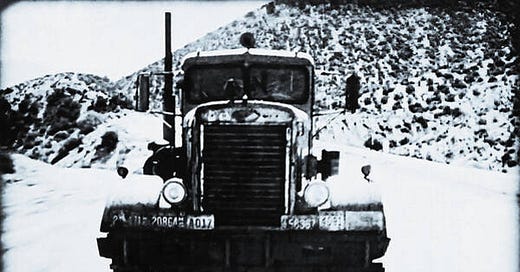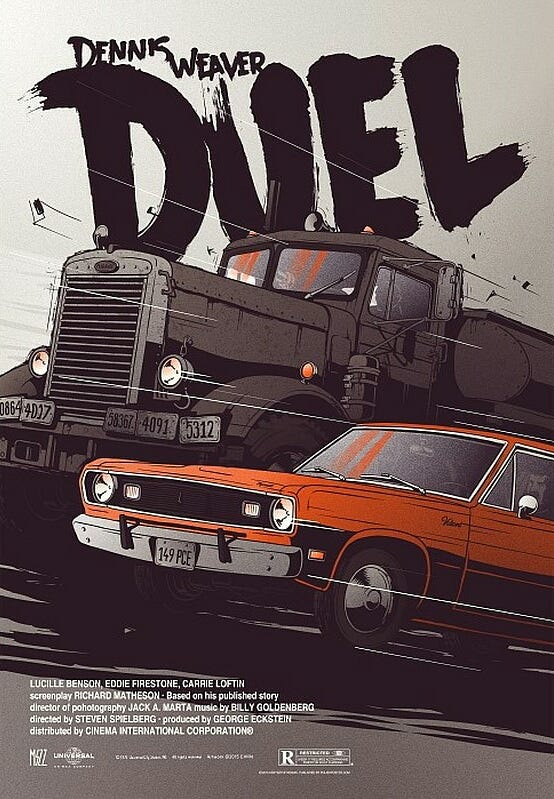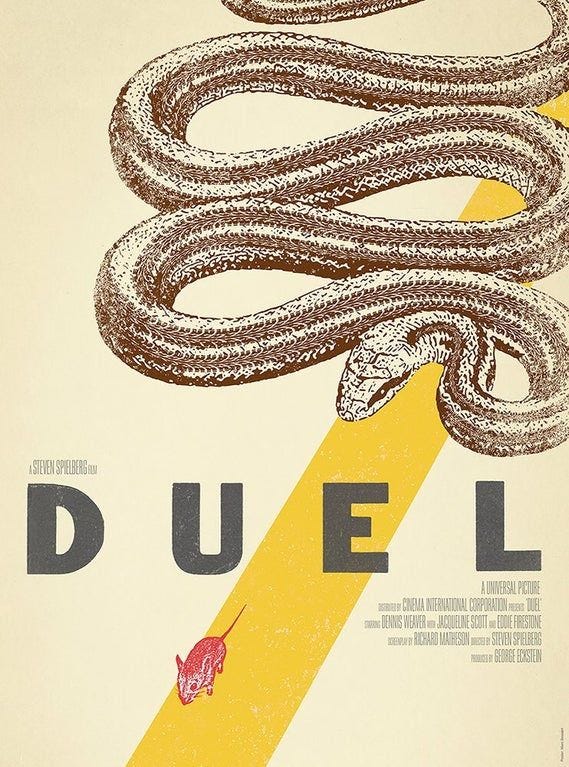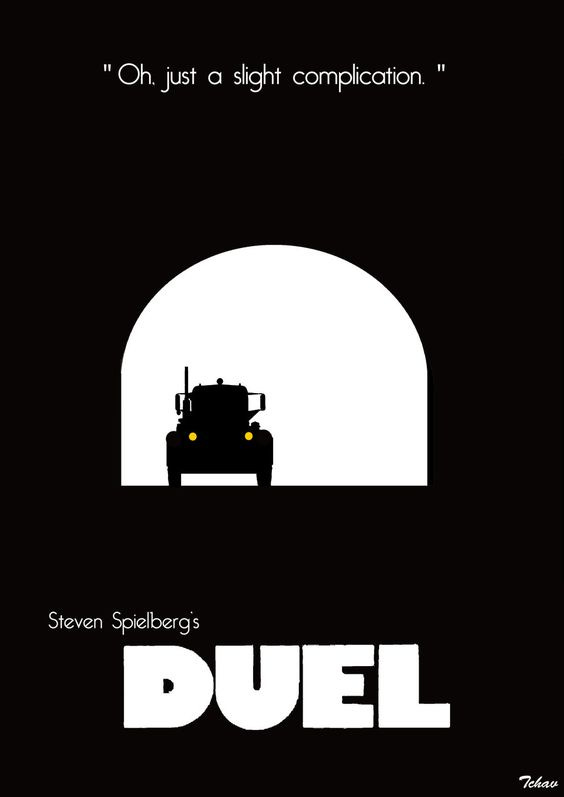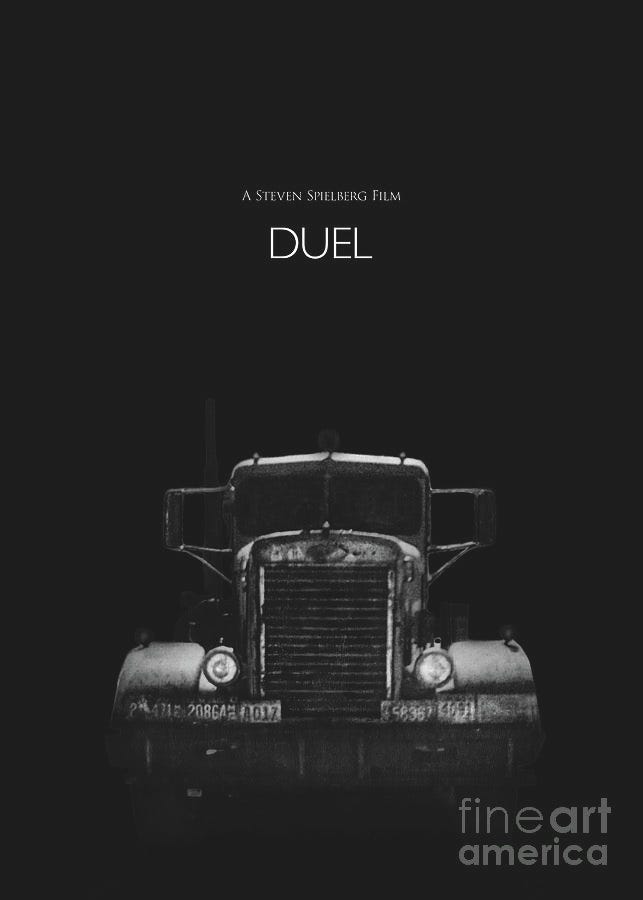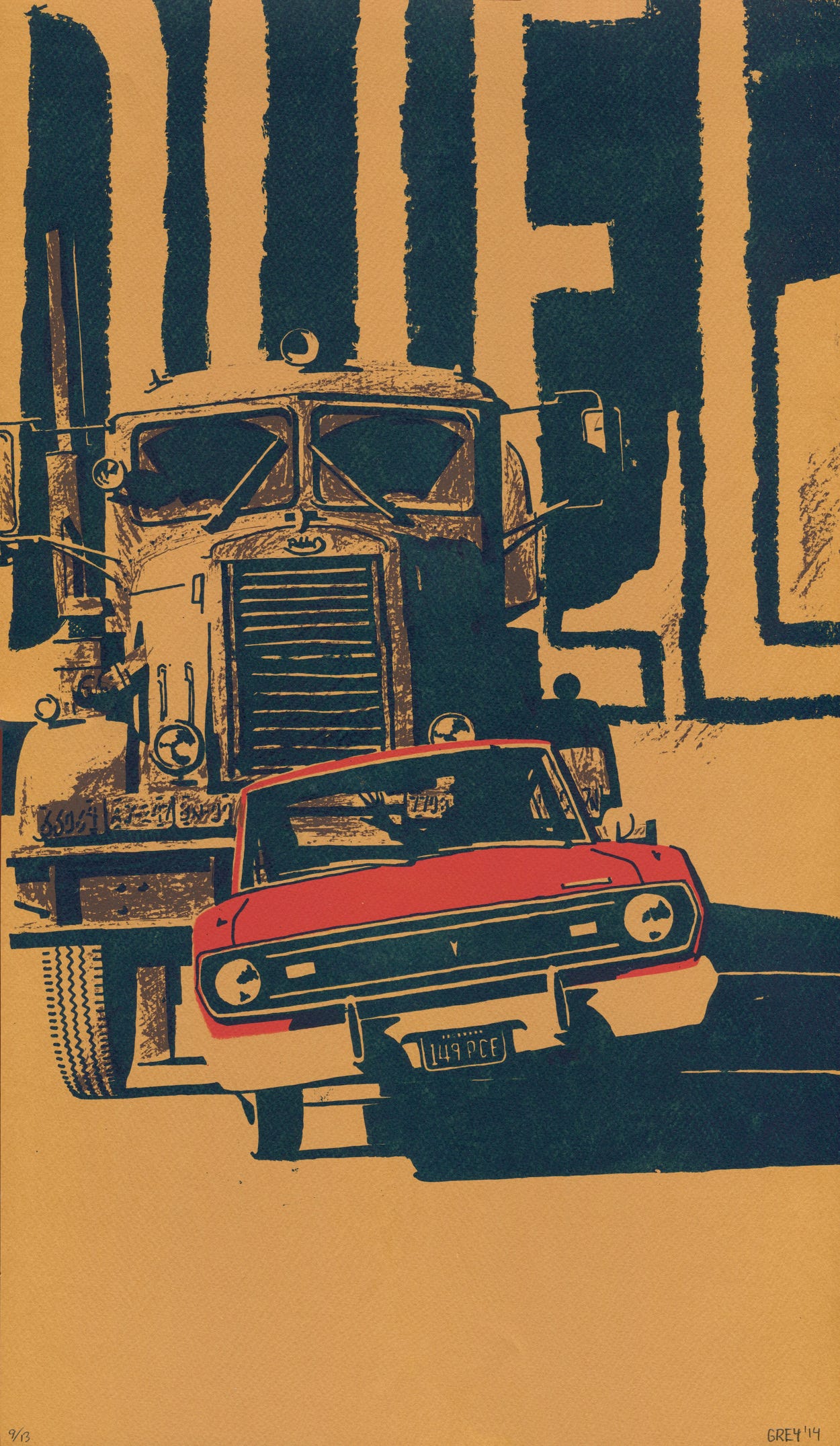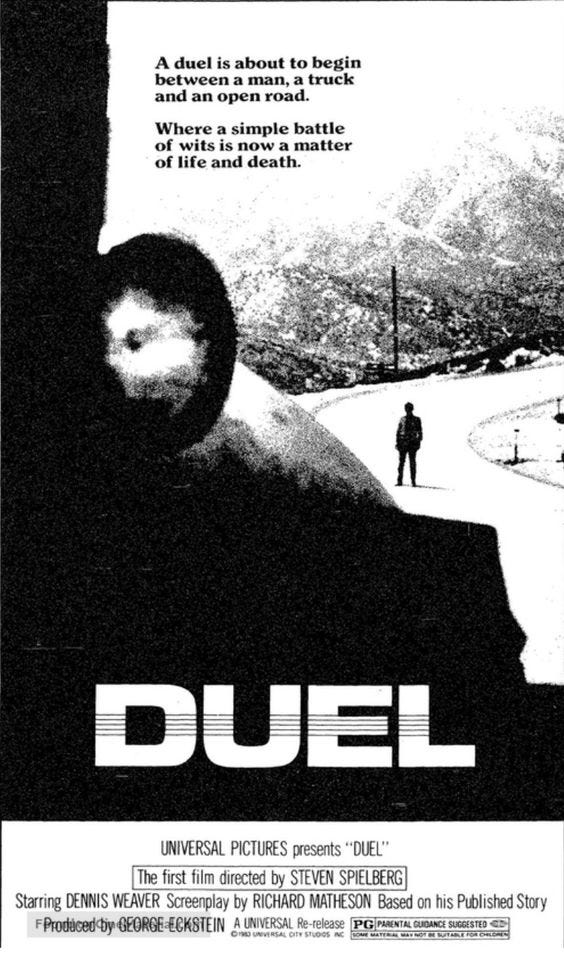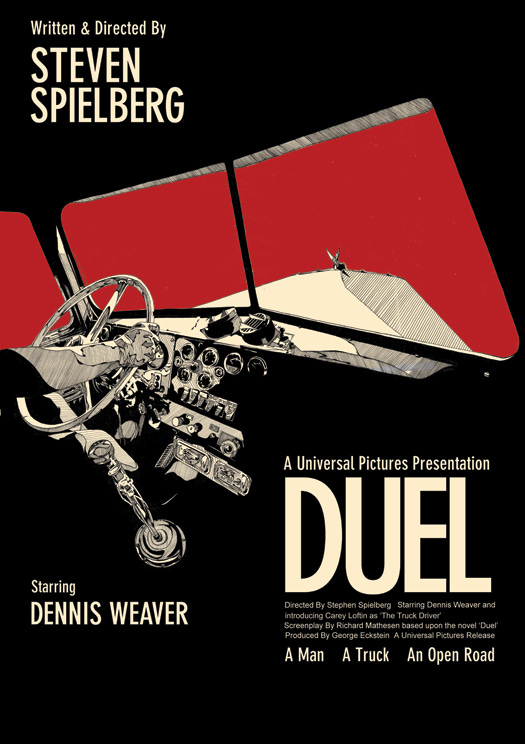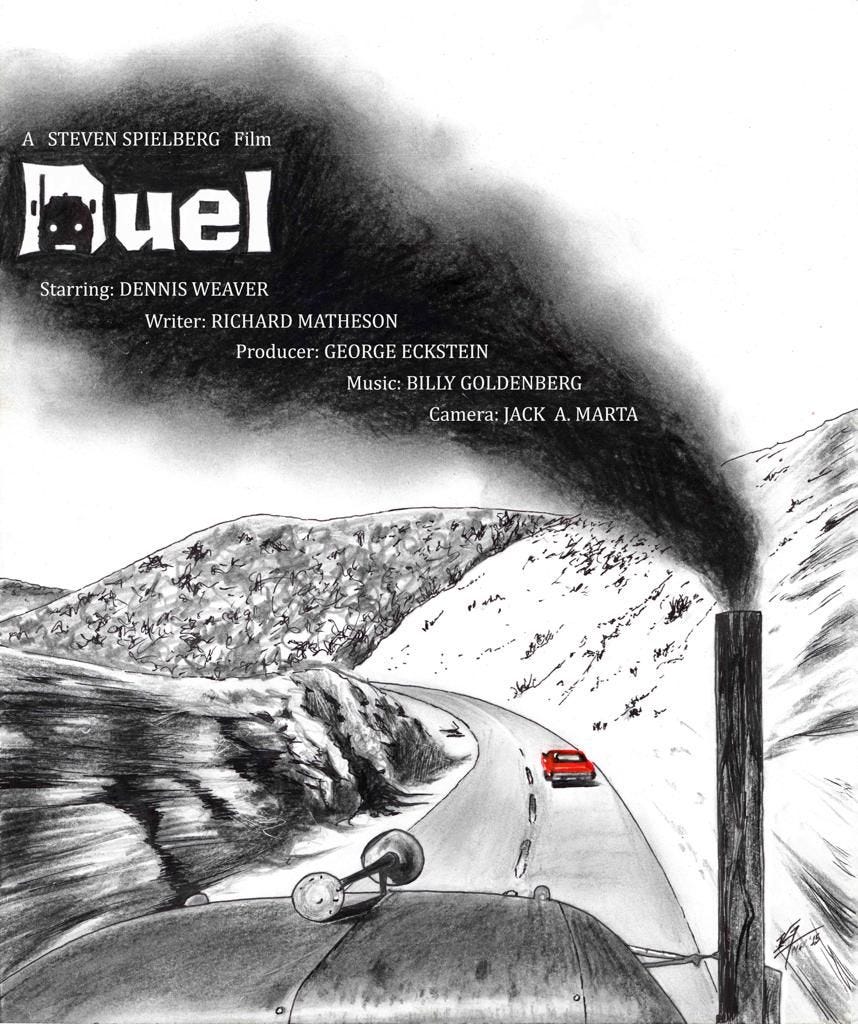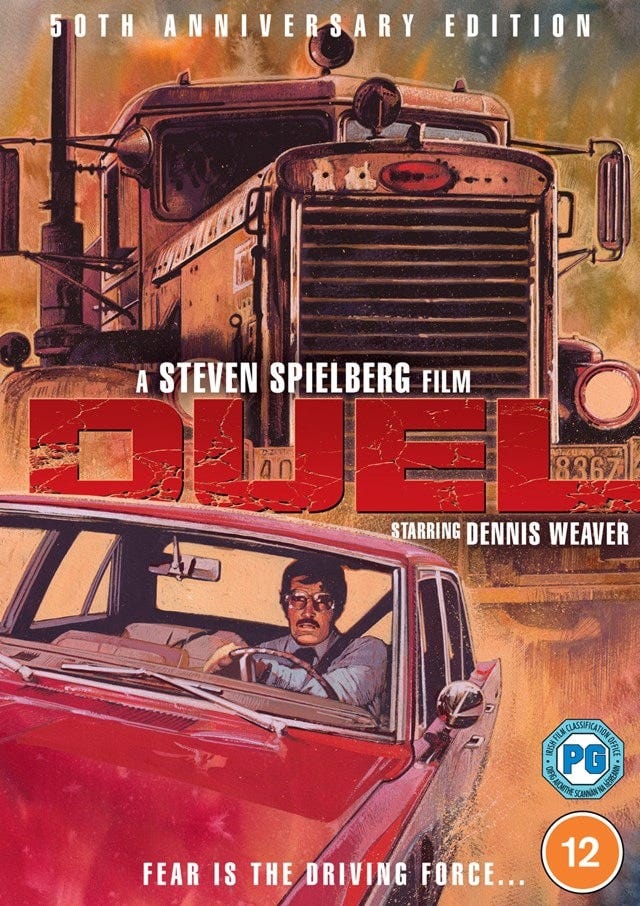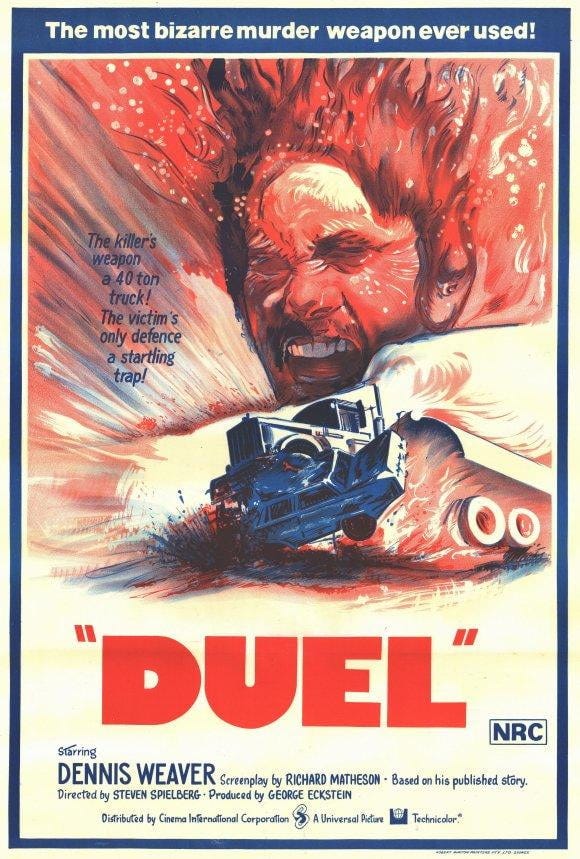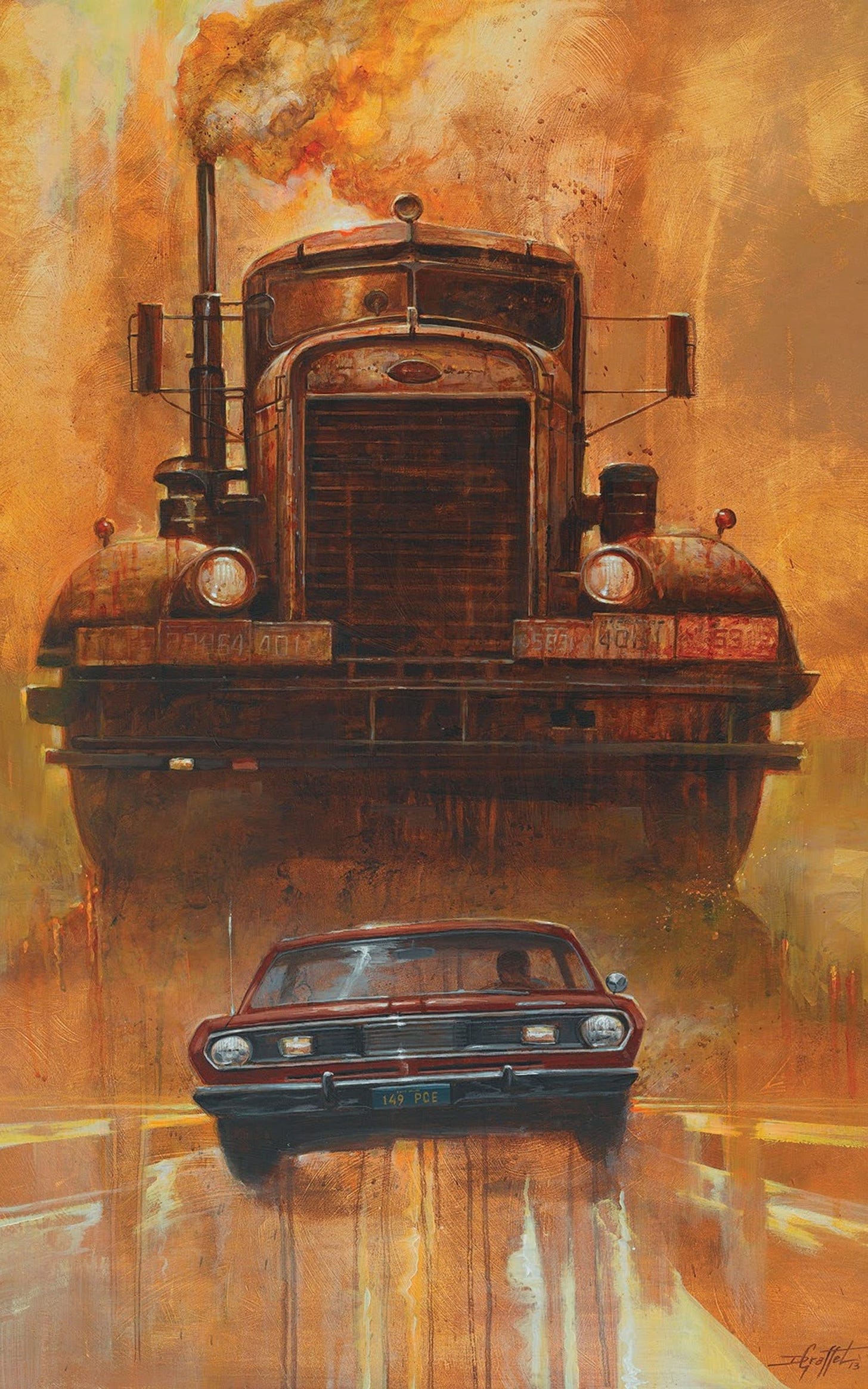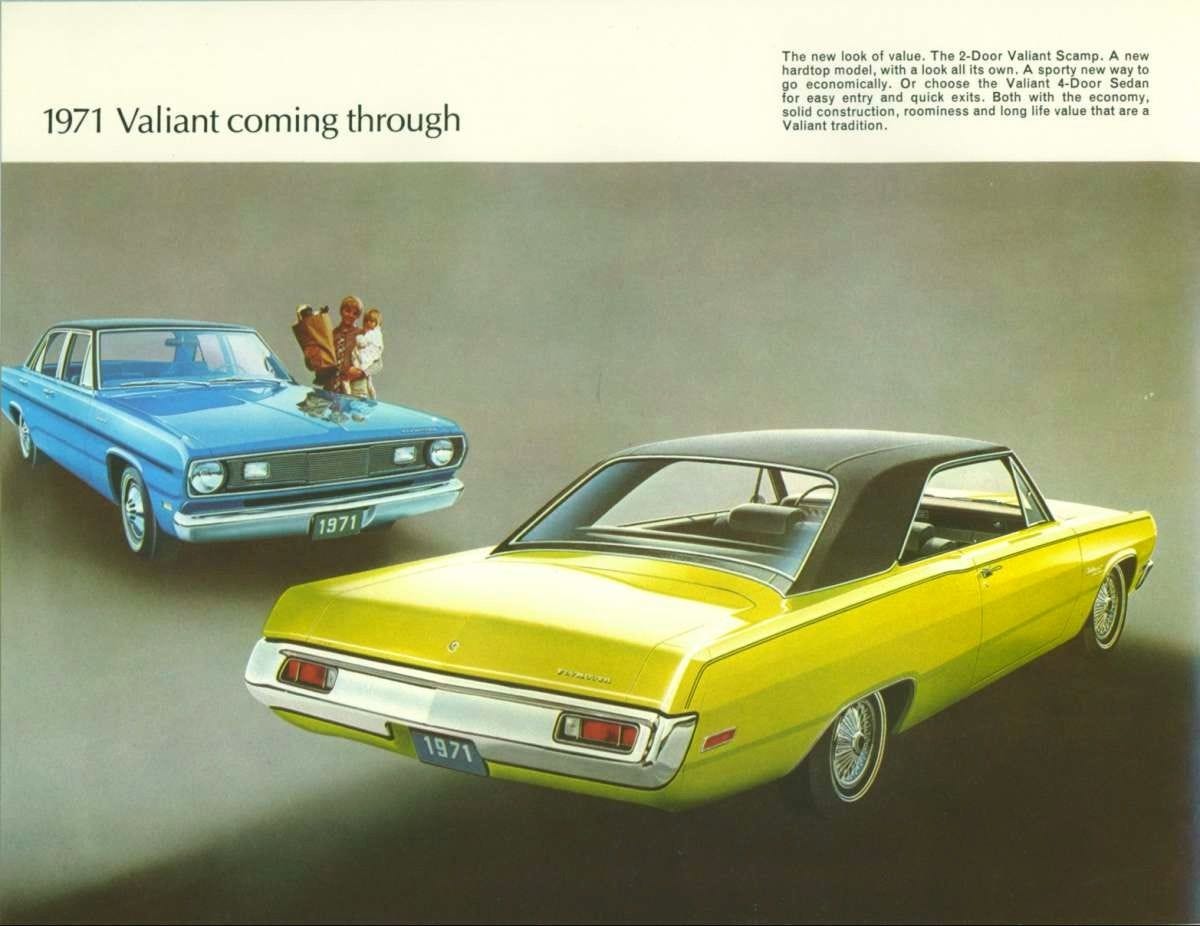The movie Duel, made in 1971 by Steven Spielberg, Is an oddball cult classic road film that was made for TV with some scenes added later to make it into a feature-film. It was based off Richard Matheson’s short story by the same name (Who also wrote the original cut of the film), which was again inspired by an event when he was tailgated by a particularly aggressive truck driver on the day of JFK's assassination.
So, Spielberg was lucky enough to come across in the Playboy magazine in 1971, however I would say that it is one of the best and the first vehicle-thriller films. The reason for that is that the movie tapped into the vehicle-supernatural genre that had only been experimented with a handful of times in the 1960s Twilight Zone TV show, those being the episodes “You Drive” and “A Thing About Machines”.
Ok so, why am I talking about this movie? Well, besides it creating a successful genre after its release (Mad Max, Joy Ride, The Car, etc), I have recently found and watched the original TV version of the movie, and it’s far better film in my humble opinion. I’ve actually wanted to talk about this movie for years now, but only recently have I discovered to TV release, and now have something unique to talk about instead.
After watching the original, I now have a new outlook on the story and the film, though keep in mind that this is just what the movie means to me. To most people, I’m sure it’s just a movie about a spooky killer truck that attacks a man until he fools it into jumping off a cliff. But, in this article, I’m going to go through the key differences from the original film and the feature release, and why they make a big difference in the story.
With the original movie, we begin out the Californian desert (No prologue driving), our protagonist David Mann is driving to a sales appointment (and not to see his boss) in his Orange 1970 Plymouth Valiant. He listens to a radio show where some guy is uncomfortable about being a put-upon househusband and whether he should check the circle “head of the family” on a government census form, blah blah blah whatever.
For Spielberg, the character of David Mann, who is the target of the trucker’s road rage in the film, was the “typical of that lower middle-class American who’s insulated by suburban modernization,” a man “that never expects to be challenged by anything more than his television set breaking down and having to call the repair man.” He doesn’t want to deal large or serious problems, that doesn’t mean that he’s weak or negligent, he just prefers to stay away from problematic situations that could escalate into something worse. Then again, who doesn’t?
As he’s driving, he comes across the old, smokey and dirty Semi truck driving in front of him going relatively slow, so naturally he decides to pass it after getting annoyed with the amount of smog coming out the exhaust funnel. He thinks nothing of it and continues to go wherever he’s going, until the truck passes him cutting him off, only just to slow down in front of him again (Dickhead move). He passes the truck again, with the truck driver letting him know he’s not happy. But David brushes it off, after all, he’s not one to hold a grudge.
Continuing on, David goes to get gas (On the wrong side of the pump), with the truck pulling up on the other side of the pump next to him shortly after him. David is a little curious to see the man who just cut him off and blew his horn at him, but all he sees are the guy’s boots. He never talks to his wife in this version, so after denying the need for a new radiator hose and giving a slight complaint about his home life, he simply goes on his way to meet his sales client. But in a matter of minutes, the Peterbilt is right on his ass.
He speeds up, hoping to give the truck driver what he wants, but the trucker just continues to ride his ass. So in his good nature he decides to let him pass, only for the truck to cut him off again and slow down, David complains and insults the truck while the driver just messes with him and refuses to let him pass, but not much else happens for bit. Until the truck lets him pass…almost into an oncoming car, and the situation becomes significantly more serious than before. “Take the old scenic route they said”, “It’ll be nice with no traffic they said.” David thinks to himself.
Unlike in the feature release, we hear David take the time to realize that they are no police where he is, it’s just him and the truck in the desert. In his desire to overtake the truck, David seizes an opportunity to fly down a side road to one up the trucker. Which works, much to his ego and pleasure. For a short while, it’s just him with his shit eating grin and the radio. But alas, the trucker is very irritated and quickly catching up to him, intending to try and one up David in a similar fashion.
A chase slowly starts to happen, David goes fast, but the truck goes faster. No matter how fast he goes, the truck is right there with him, to a point where both of them are tearing through the desert like there’s no tomorrow. With the truck getting right on him and honking at him every time it catches up, as if to berate him for trying to outrun it in the first place. But the truck never actually touches him, they added sound effects in the feature version to make it sound like the truck was tapping his bumper, but it actually never did.
Finally, David gives in to the pressure and flys off the road, goes through a parking lot and into a fence across the street from a restaurant, thinking that the truck driver was attempting to kill him. A nice older fella checks on him to make sure he’s alright, which afterward David goes to the cafe to wash up and think over everything that just happened. But hey, he’s still alive, and it’s over now.
The reality of the situation hits him, realizing that his actions put him in the path of something that he wasn’t capable of handling himself. Normally this wouldn’t be a problem, but after seeing the truck sitting in perfect view just outside of the cafe, he realizes that he needs to think carefully about his next course of action. What should he do? What are his options? How can he fix this? People in the diner laugh at him and look at him like he’s crazy.
He stares at the other men in the diner, thinking that one of them must be the driver of the dirty rig waiting for him outside. But food, water, and an aspirin will certainly help his thought process. After all, he just passed the truck a couple of times and it chased him down. The truck driver is clearly crazy, but what can he do about it? He is alone, there is no police, and the people in the diner think he’s mental.
He puzzles himself, the truck sitting idle outside the window, wondering if the truck will continue to attack him after him leaves. Why he didn’t leave the second the he saw truck was outside is unknown, perhaps he was unsure of how to face it, though his slight mental panic is enough evidence of that. He seems to think that he can’t outrun the truck for one reason or another, despite the fact that his car is actually much more nimble than the truck is.
Normally, trying to talk things out might’ve not be the worst idea, but that only works if you know who it is, and you remain somewhat calm, which he does neither. Good thing he didn’t call the police, other he would’ve been the one to get arrested after threatening a random stranger, and getting his ass handed to him after he went up to the guy sounding crazy. No wonder he wasn’t taken seriously.
It makes even more sad when it turns out the truck driver was never in the diner to begin with, he was probably looking over Davids car or taking a piss in the bushes. David attempts to run after the truck still going in the same direction, but it doesn’t even notice him. All that’s really left to do is the walk of shame back to his car and continue on his way, deciding just to take it easy and not worry about being late.
But this thought process lasts all of a minute after he sees that the truck driver was nice enough to wait up for him, and then continue to drive even slower than before, so David does the adult thing to do in this situation: Pull over to the closest gas station and call the police, which happens far earlier in this version of the film. As both of the scenes with the school bus and the train never happens in this version, making when David decides to call the police far more reasonable.
However, the truck driver isn’t happy with David trying to end the game, so the driver charges him while he’s in the phone booth, but gives him a loud honk as to alert him to get out of the way. The truck proceeds to crush everything in its temper tantrum, making this the first moment in the original film where the truck poses a real threat. David throws one of the broken animal cages at the truck, but it has about the same effect as throwing a glass at a steel wall.
David has to flee before the radiator hose can be changed, but manages to get far away from the truck enough to have the time get off the road and hide on the other side of a hill by the train tracks, where he intends to stay for a while until the hopefully the truck is far away from him. But it doesn’t matter, because the truck isn’t just out there, it’s in his head too.
A train going by the tracks he’s sitting by startles him awake, he laughs at the fact that he thought it was the truck in the first place, as it disappeared a while ago. He continues driving yet again, despite the fact he’s late and is now probably not the highest ranking salesman for his company. But low and behold, the truck is waiting for him around the next corner, like if it always seems to know where he is, or if it actually saw where he was trying to hide from it.
Stopping sideways in the middle of the road, someone else coming around the corner almost hits him. The truck may not have to be the one to do the attacking at this rate, as it’s starting to make David act irrational. David’s first idea to run at the truck hoping to get by him, but the truck pulls out into the road to simply block his path. Making him turn around, go back, and pull over again. With the truck reversing itself to where it was waiting for him before.
At this point, David has had enough, yes he’s scared, but also tired and angry. He wants the truck driver to stop pushing him around, but he doesn’t know how to get that to happen. (Why he doesn’t just turn around is beyond me, would the truck still follow him?) So he tries something that he was afraid to do originally, go up to the driver and speak to him on foot, some hopeful music plays in the background as he walks determinedly to the truck.
To his surprise, the truck driver begins to drive away from him, but not quickly, just fast enough to outrun him at a running distance. It pulls over and stops when David stops his foot pursuit, it appears that this is a problem that requires an action, not a discussion. But David takes the action to stop another driver and beg them to call the police at the next gas station, which ended up not being the correct action needed.
The big rig backs up, taking aim at his car while the stopped motorists flee, but doesn’t touch it. And David seems to get a better understanding of what to do, similar to a classic western with a gunslinger throwing a weapon to the person he challenged. This is where the “duel” part actually happens in the movie, David mentally preparing to take on the truck, armed with only his car, his suitcase, his seatbelt, and his courage.
A mutual understanding seems to have happened, the truck doesn’t block him again, but lets him pass. David takes off again one more time, knowing that’s what the truck driver wanted, to keep him in front. But with newfound courage and confidence, David can finally take the truck on. And he knows where to go, as there’s a pass around 5 miles away from where he is, the truck will certainly have a hard time keeping up with him on such a steep grade. Why they took away the dialogue with him explaining where his was going in the feature release is beyond me.
Thankfully, Plymouth Valiant’s are relatively light cars, weighing in at around 3000 pounds. So it can carve the mountain corners pretty well, staying ahead of the truck. But while driving, David thinks he sees a police car, only to stop and see that’s it’s actually a pest control car with a police like livery. Causing him to lose almost all the ground he gained on the truck, and the truck to take a quick aim at the pest control worker, just to let him to know to stay out of the situation.
Unfortunately, David ends up having to take a slight detour due to the main road being blocked off, and loses his composer a little due to now being on an unfamiliar road. The two vehicles pass a moving train, appearing to be the same one that startled David before. The truck gives a quick honk to the train, the train responds, and we now hear how similar both horns actually sound in the original version.
While driving, David has a plan to outrun the truck at the pass, but he’s unsure if he can maintain high speeds on those roads. But for a course correction, he just reminds himself that he’s being chased down by someone who is trying to kill him, good motivation. While coming into the pass a bit hot, he immediately starts to gain distance between him and the truck.
But alas, poor future planning bites him in the ass, as his car starts to overheat due to the radiator hose finally giving up over the large strain it’s been put through for the last hour. The car it practically engulfed in its own smoke (Make no mistake, classic cars did overheat like this), as David begins to panic, pleading with the car (And himself) as he watches the car slow down to a crawl.
Thankfully, David’s car (The car that’s overheating at least) Has a slant 6 in it, as you can hear from the sound of the actual engine cutting out. There engines are notoriously tough to kill and have a habit of holding together pretty well, so he still manages to reach the top of the summit without the engine completely dying. Albeit the truck has caught up to him, but now since it’s all downhill from here, he can simply just let the car coast down. Not that the engine would be able to fully cool off in the amount of time it takes to get to the bottom.
When David does get to the bottom however, he attempts to take a small corner at high speeds, causing him to crash into the hill (Admittedly, the car took the impact surprisingly well). And you finally get to hear the classic Mopar starter sound when David it’s trying to restart the car, something which was deprived of us in the feature version, sacrilegious if you ask me.
Of course, David manages to start his car just it time (This trope was new back then), and slip away from the trucker. Driving up on a dirt road, high in the desert mountains in his wounded car, he has run out of road to travel. But, he does have to face the truck one way or another. With the truck coming right at him at full steam, he decides that he is going to charge at it, and then jump out of him car, hopefully without the trucker noticing.
This seems to work, as the truck hits the car, it bursts into flames. Causing the truck driver to have limited vision of what’s in front of him, or rather lack there of, as the driver sees the cliff at last last minute with no time to slow down. Both the truck and car crash down the cliff, smashing both vehicles to bits and pieces.
Finally, after the dust settles, David is overjoyed to have beaten the truck. He watches the wreck for a moment just to make sure that the driver doesn’t crawl out of the wreckage, but only silence remains. With the fan in the truck still going, and oil dripping down the steering wheel (Some people have said it’s supposed to be blood, but it looks nothing like blood).
After the last wheel stops moving, David can finally rest, the truck and its driver are no more. He’ll worry about getting home and explaining things later, for now all he needs to do is rest on the edge of the cliff, with the memory of an unforgettable experience. And a changed man.
It’s actually a very simple and straight forward film in its original state, really takes away many theories that people had about the movie. I think this version is far superior for several reasons. In this version, David Mann as a character, isn’t portrayed as nearly as emasculated or confusing. But a rather adult who’s just slightly annoyed by his wife’s nagging, and he responds to what the driver of the truck does far more sensibly too.
Why they cut so much of David’s dialogue out of the theatrical cut, I will never know or understand, as it provides us a far better understanding of who he is as a person and what he’s going to do. Rather than just leaving us in the dark for most of the movie, we understand why he chooses his actions.
Spielberg thought that by concealing the truck driver’s identity in Duel, it would give the film a “supernatural” quality. But I’m honestly not sure, it least not in the “Evil Spirit” type of way. Sure, hiding the truck driver’s face forces the audience to use their own fears and imagination, but in reality it’s a ghost truck at best and a lunatic driver at worst. Though, Matheson seemed to paint many details to set up the dichotomy between a man too soft and a man presumably tough as gristle, with the man too soft becoming stronger at the end of the film.
In this story, Mann is entirely on his own, and he won’t be able to rely on anyone else to settle the score the trucker has set for him. He was forced into a situation to where he had to become stronger, or the problem would end him. And strangely enough, the word “Valiant”, which is also the model of his car, means: Possessing or exhibiting valor, intrepid in danger, or being courageous. Just a coincidence, but a neat one. You could maybe even argue that David’s experience with the truck, despite it being scary and deadly, was also necessary for him to grow as a person.
Here’s the original cut, I suggest you give it a watch - https://archive.org/details/DUEL71ABCTV
Also next article won’t be a long analysis of a film, I promise.


